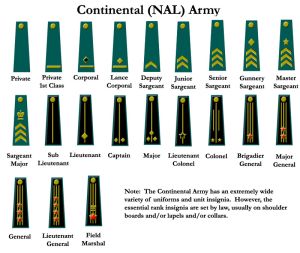Continental Army
From IBWiki
Jump to navigationJump to search
| This article is source material
|
- The NAL-SLC has an armed force (army, navy, coast guard, air corps, gendarmery).
- The land armed force of the NAL-SLC as a whole is called the Continental Army.
- It is a full participant in the Commonwealth of Nations, which has a military/defense arm in addition to the economic and cultural arms.
- The NAL-SLC participated with high honours in the Great Wars.
- It had long skirmished with Florida-Caribbea and eventually played a major role in the Grand Coalition during the 2002 War which toppled the military Junta and liberated all the territories (most of which are fellow Commonwealth territories and two of which are NAL provinces) of the Caribbean basin.
- The NAL-SLC as a whole and the province of New Sweden in particular participate in joint military exercises with the Scandinavian Realm.
- Each American province supports its own militia. Militias consist of various ground, air and maritime (coast and river guard) forces.
- The provinces operate their militaries according to the traditions of their homelands, modified to the facts of unification within the Solemn League and Coveneant. This could be interesting on account of their being Native, Spanish and Scandinavian homelands as well as Scottish, Kemrese and English.
- In time of War, a General Commander of the Continental Army is chosen who acts as commander in chief or five-star general.
- As discussed in relation to Mueva Sefarad, some provinces (mostly Native, but also others) have war-paint traditions.
- The navy of the NAL has the somewhat antique name of Solemn League Navy.
- Americans are not restricted to service in the forces of the NAL. Many Americans have distinguished themselves in the service of their Britannic Majesties in a variety of armed forces around the world.
- Since the end of the 1828 War and the start of a long peace along the NAL's borders, a patriotic tradition of enlisting in the FK military had developed. This was, surprisingly, particularly strong in the Native Provinces of the Great Lakes, Aquanishuonigy, Miami, and Ouisconsin. The warrior tradition was still very much a part of society, and fighting for the Grandfathers (as the British monarchs are known) had long been an acceptable path for a warrior to follow. The Native units in the Crimean War were notoriously independent, often wandering behind enemy lines to raid or forage, but they also distinguished themselves through their bravery. This tradition of enlisting in the Federated Kingdoms' forces lasted until the middle of the Second Great War, when the NAL joined the war and these units were transferred to League command.
- Known forts of CA: Fort Braf, outside of Watlings Pond, UT.
